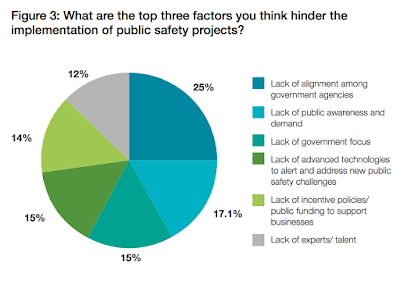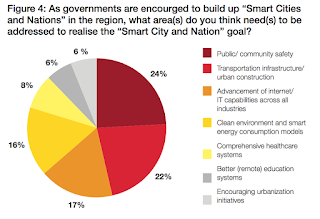Smart City Survey Results: Governments Need to Be Smarter About Keeping
Cities Safe
Keith Roscarel, Director Smart Spaces and Video Intelligence – Asia Pacific, Hitachi
Vantara
A
recent Safe Cities survey offers a revealing snapshot into the plans and progress
of public safety initiatives across Asia Pacific, and why integration is the
key to success.
recent Safe Cities survey offers a revealing snapshot into the plans and progress
of public safety initiatives across Asia Pacific, and why integration is the
key to success.
If Asia Pacific
is on track to emerging as the world’s most powerful economic region, its
cities are also on their way to becoming some of the planet’s smartest.
is on track to emerging as the world’s most powerful economic region, its
cities are also on their way to becoming some of the planet’s smartest.
A recent report
predicted the number of smart cities worldwide to quadruple over the next ten
years, with Asia Pacific expected to see the highest number of smart cities,
reaching 32 by 2025, ahead of Europe and the Americas.
predicted the number of smart cities worldwide to quadruple over the next ten
years, with Asia Pacific expected to see the highest number of smart cities,
reaching 32 by 2025, ahead of Europe and the Americas.
But what does the
term smart city actually mean? Gartner defines a smart city as an urbanized
area where multiple sectors cooperate to achieve sustain- able outcomes through
the analysis of contextual, real-time information shared among sector-specific
information and operational technology systems. Indeed, one of its reports
estimates that smart cities accounted for more than 1.1 billion Internet of
Things (IoT) items in 2015, rising to 9.7 billion by 2020.
term smart city actually mean? Gartner defines a smart city as an urbanized
area where multiple sectors cooperate to achieve sustain- able outcomes through
the analysis of contextual, real-time information shared among sector-specific
information and operational technology systems. Indeed, one of its reports
estimates that smart cities accounted for more than 1.1 billion Internet of
Things (IoT) items in 2015, rising to 9.7 billion by 2020.
The question that
needs to be answered is can smart cities be safer places for people to live and
work? And what role does the advancement of technology and IoT have to play in
delivering public safety?
needs to be answered is can smart cities be safer places for people to live and
work? And what role does the advancement of technology and IoT have to play in
delivering public safety?
To find the
answers, Hitachi conducted a survey of delegates at the Safe Cities Asia
conference in Singapore. The event was attended by city government
representatives, agencies and key municipal leaders from Asia Pacific, who
discussed public security and safety challenges.
answers, Hitachi conducted a survey of delegates at the Safe Cities Asia
conference in Singapore. The event was attended by city government
representatives, agencies and key municipal leaders from Asia Pacific, who
discussed public security and safety challenges.
Over a quarter of
the respondents had a technology background of some kind, with the rest ranging
from city mayors and corporate CEOs to military, emergency services, and
providers of infrastructure such as transportation and logistics (Figure 1).
the respondents had a technology background of some kind, with the rest ranging
from city mayors and corporate CEOs to military, emergency services, and
providers of infrastructure such as transportation and logistics (Figure 1).
In short, the
survey provided the right sample base to identify the role that technology is
currently playing, and could play in the future, when it comes to delivering
safer cities.
survey provided the right sample base to identify the role that technology is
currently playing, and could play in the future, when it comes to delivering
safer cities.
Serious
Money Being Earmarked For Safer Cities
Money Being Earmarked For Safer Cities
The results of
the survey have been extremely revealing. Nearly 90% of respondents said that
either they or their organisations had already been involved in a safety
project. Moreover, 69% of respondents are planning to invest in public safety
projects in their countries over the next two years.
the survey have been extremely revealing. Nearly 90% of respondents said that
either they or their organisations had already been involved in a safety
project. Moreover, 69% of respondents are planning to invest in public safety
projects in their countries over the next two years.
Nearly half (44%)
of the respondents estimated that their countries would invest more than US$100
million in public safety projects during the next two years. Some 22% of them
predicted that the investment would be higher, at between US$100-500 million,
while nearly 14% anticipated spending over US$1 billion (Figure 2).
of the respondents estimated that their countries would invest more than US$100
million in public safety projects during the next two years. Some 22% of them
predicted that the investment would be higher, at between US$100-500 million,
while nearly 14% anticipated spending over US$1 billion (Figure 2).
This also raises another question: do
governments know the best way to spend that money? When it comes to public
safety, the answer might be no.
governments know the best way to spend that money? When it comes to public
safety, the answer might be no.
Are
Governments Helping Or Hindering Public Safety Projects?
Governments Helping Or Hindering Public Safety Projects?
The majority of
survey respondents (25%) felt that a lack of alignment between government
agencies was actually holding back the implementation of public safety
projects.
survey respondents (25%) felt that a lack of alignment between government
agencies was actually holding back the implementation of public safety
projects.
One of the most
popular reasons cited for sluggishness towards public safety is simply a lack
of government focus; an odd finding considering that public safety is one of
the primary responsibilities of any government (Figure 3).
popular reasons cited for sluggishness towards public safety is simply a lack
of government focus; an odd finding considering that public safety is one of
the primary responsibilities of any government (Figure 3).
The main barrier
to progress appears to be a failure to adopt an integrated approach to safety
initiatives. The ideal solution would be to start by involving as many stakeholders
as possible in the planning process, resulting in an execution that enables the
implementation to play a wider role in making the city smarter and as safe as
possible.
to progress appears to be a failure to adopt an integrated approach to safety
initiatives. The ideal solution would be to start by involving as many stakeholders
as possible in the planning process, resulting in an execution that enables the
implementation to play a wider role in making the city smarter and as safe as
possible.
Technology
Tackling Crime
Tackling Crime
When asked what
areas needed to be addressed to realize the ‘Smart City’ goal, 22% of the
responses had to do with physical development initiatives, including urban
construction projects and enhancing or expanding transportation infrastructure.
The advancement of Internet and IT capabilities was also high on the list, with
a 17% response rate (Figure 4).
areas needed to be addressed to realize the ‘Smart City’ goal, 22% of the
responses had to do with physical development initiatives, including urban
construction projects and enhancing or expanding transportation infrastructure.
The advancement of Internet and IT capabilities was also high on the list, with
a 17% response rate (Figure 4).
A staggering 95%
of respondents rated the role of technology in ensuring public safety as
Important or Very Important. The public safety technology that most plan to
invest in over the next two years is surveillance, followed by big data
analytics, and mobile and network technology (Figure 5). Indeed, the
convergence of all three offers tremendous scope for improving both safety and
security in modern cities.
of respondents rated the role of technology in ensuring public safety as
Important or Very Important. The public safety technology that most plan to
invest in over the next two years is surveillance, followed by big data
analytics, and mobile and network technology (Figure 5). Indeed, the
convergence of all three offers tremendous scope for improving both safety and
security in modern cities.
The lessons
learned from the big data revolution suggest that integration – exploiting the
capabilities of a variety of interconnected systems in real time – offers far
more value than standalone solutions in improving public safety.
learned from the big data revolution suggest that integration – exploiting the
capabilities of a variety of interconnected systems in real time – offers far
more value than standalone solutions in improving public safety.
Cities that fail
to take a holistic, fully integrated approach to planning for the future are
likely to remain stuck with the problems of the past.
to take a holistic, fully integrated approach to planning for the future are
likely to remain stuck with the problems of the past.
One of these
perennial problems is crime (Figure 6). However, some police forces are
recognizing that integrating new IT platforms with other city resources can
have a dramatic impact in driving down crime rates and increasing public
safety.
perennial problems is crime (Figure 6). However, some police forces are
recognizing that integrating new IT platforms with other city resources can
have a dramatic impact in driving down crime rates and increasing public
safety.
Urbanization and
transportation play important roles in monitoring and preventing crime by
identifying criminal acts, or potential criminal acts, in advance. This can be
done through advanced technology by combining and analyzing data from a variety
of sources, such as video cameras on trains, in department stores and scattered
throughout the city, as well as other data on social platforms such as Twitter.
Powerful analytics tools digest the totality of the information to extract key
insights that can identify crime hot spots.
transportation play important roles in monitoring and preventing crime by
identifying criminal acts, or potential criminal acts, in advance. This can be
done through advanced technology by combining and analyzing data from a variety
of sources, such as video cameras on trains, in department stores and scattered
throughout the city, as well as other data on social platforms such as Twitter.
Powerful analytics tools digest the totality of the information to extract key
insights that can identify crime hot spots.
Conclusion
The ultimate goal for any city – smart or
otherwise – is to create an environment where people can live without worrying
about safety.
otherwise – is to create an environment where people can live without worrying
about safety.
The secret to
creating smarter and safer cities is not to work a little harder in a few
specific areas. The real solution is to stop looking at each of these safe city
components in isolation. To be truly effective, a municipality should view and
manage all of the various parts together holistically. This allows each piece
of the smart city puzzle to support the others. Moreover, by taking an
integrated approach and employing more comprehensive analytics, the potential
benefits multiply tremendously.
creating smarter and safer cities is not to work a little harder in a few
specific areas. The real solution is to stop looking at each of these safe city
components in isolation. To be truly effective, a municipality should view and
manage all of the various parts together holistically. This allows each piece
of the smart city puzzle to support the others. Moreover, by taking an
integrated approach and employing more comprehensive analytics, the potential
benefits multiply tremendously.
For the LATEST tech updates,
FOLLOW us on our Twitter
LIKE us on our FaceBook
SUBSCRIBE to us on our YouTube Channel!










